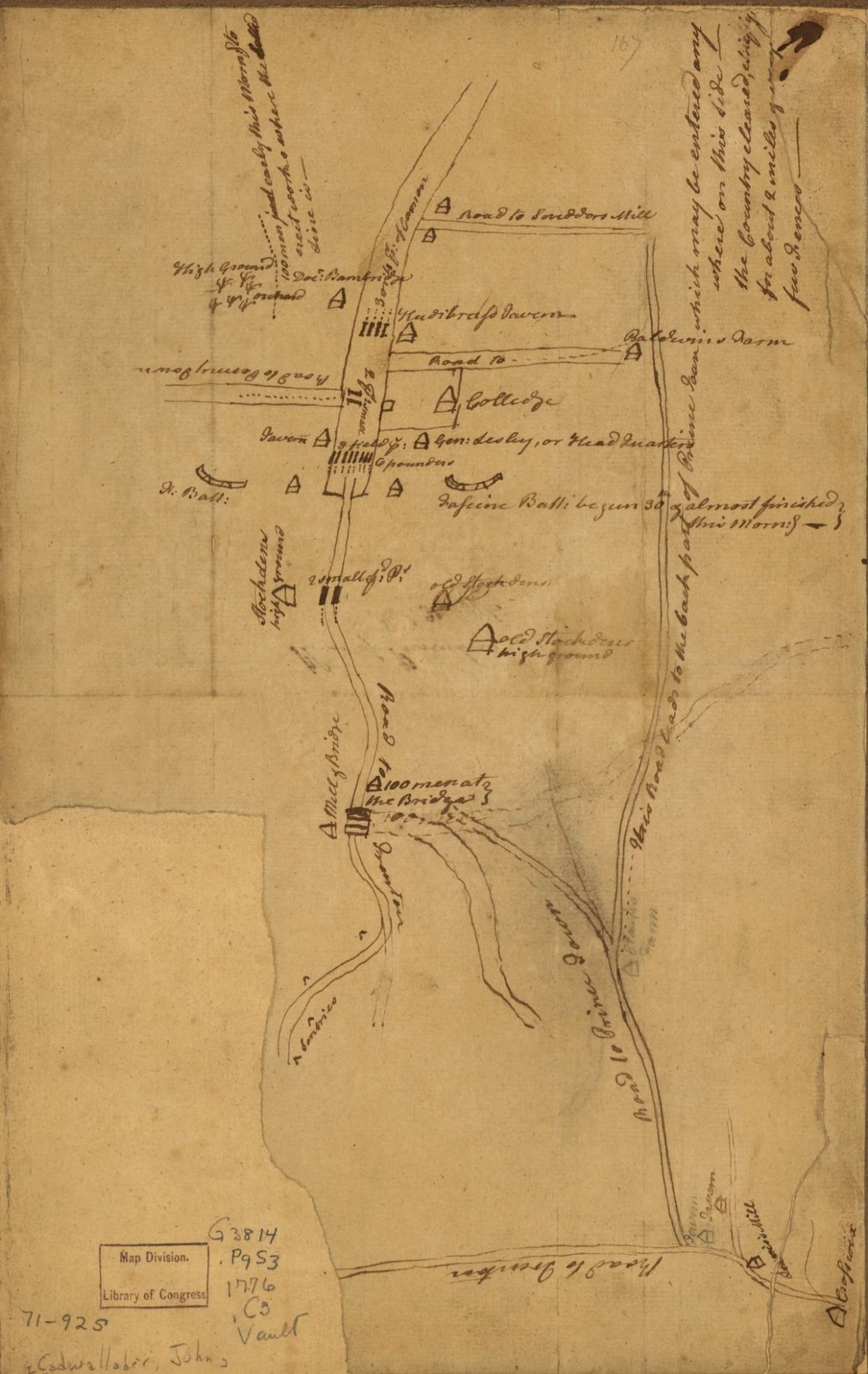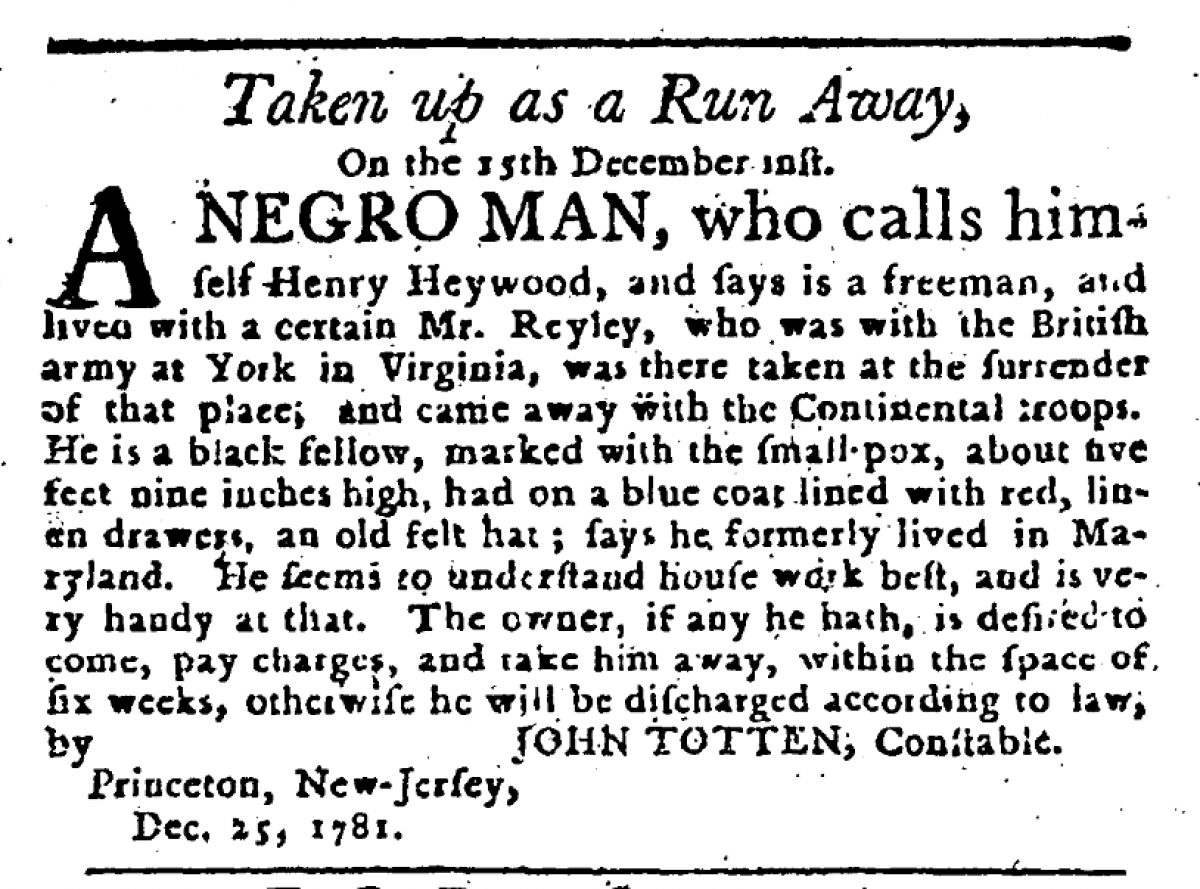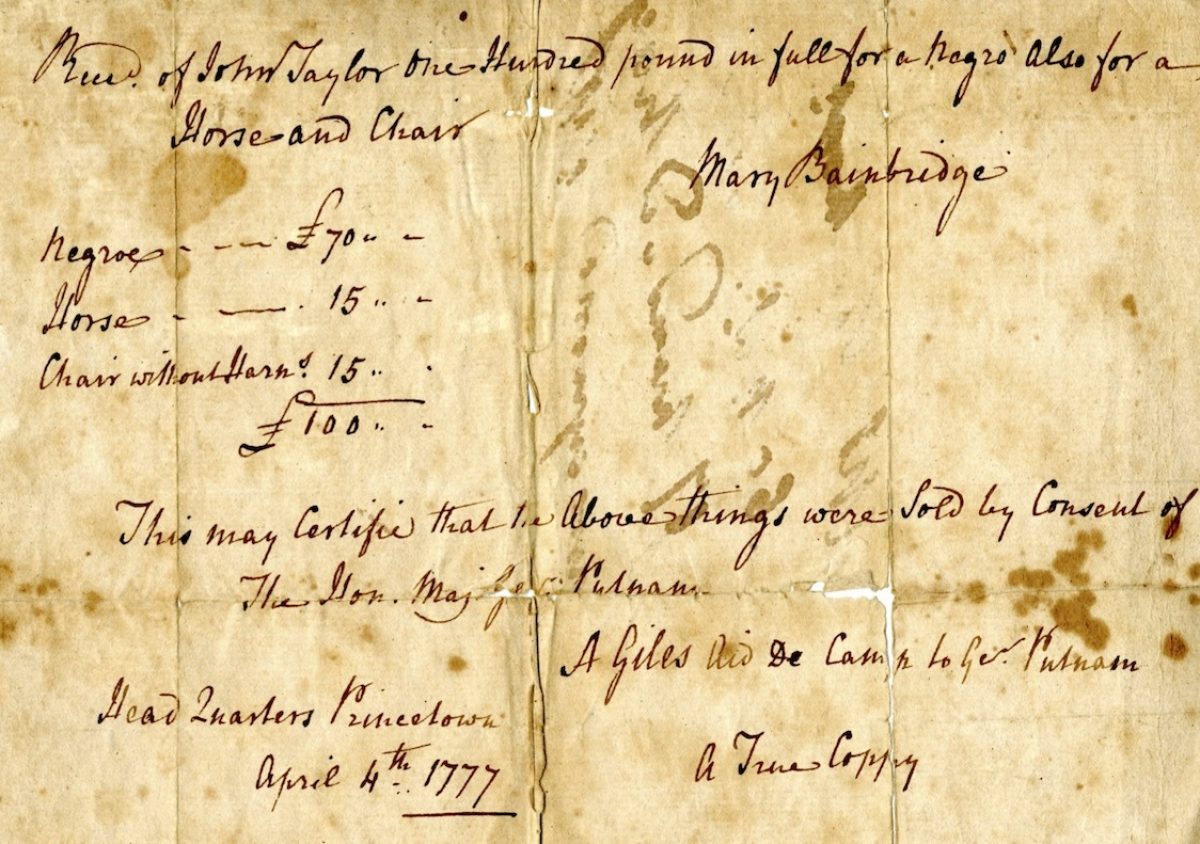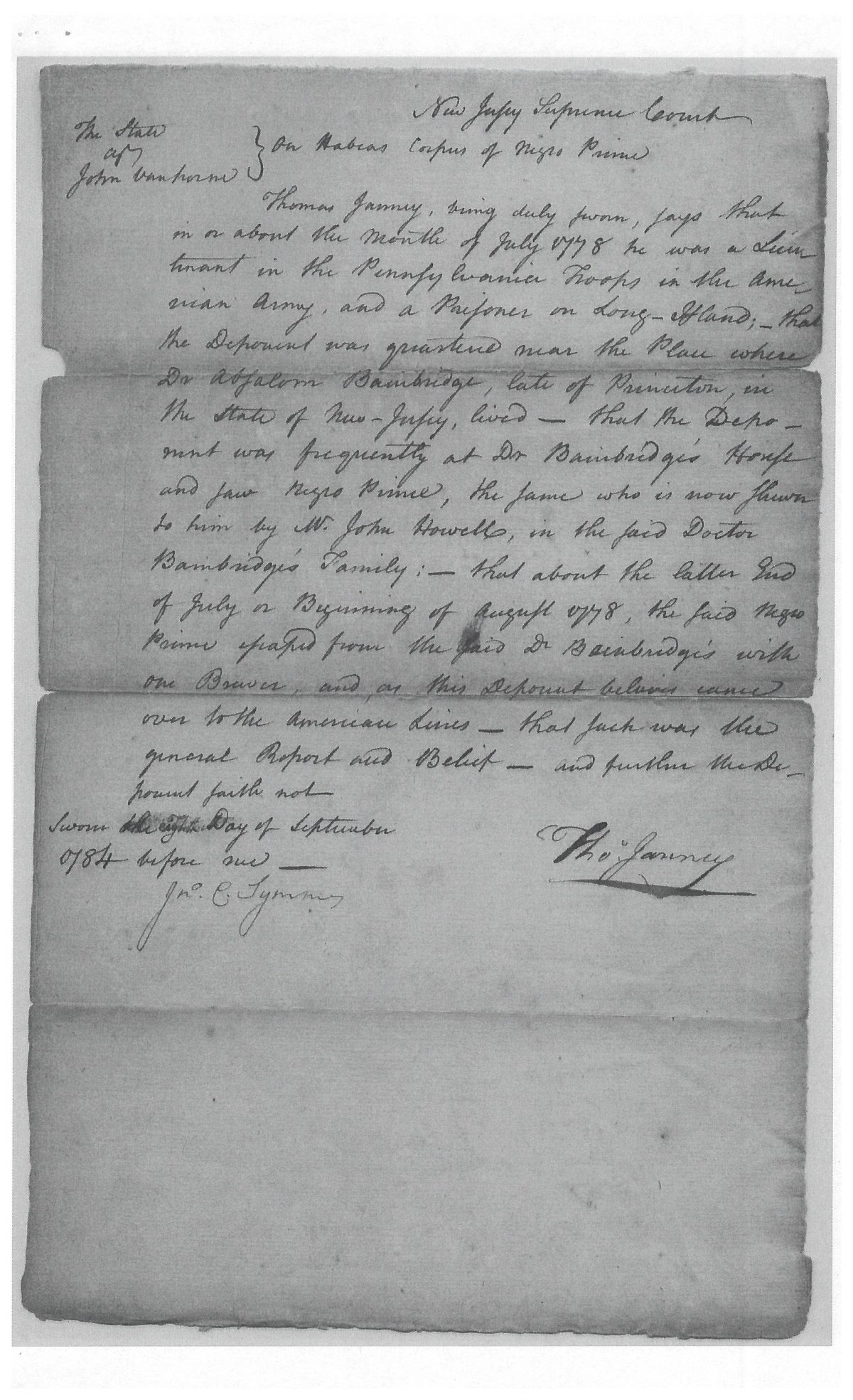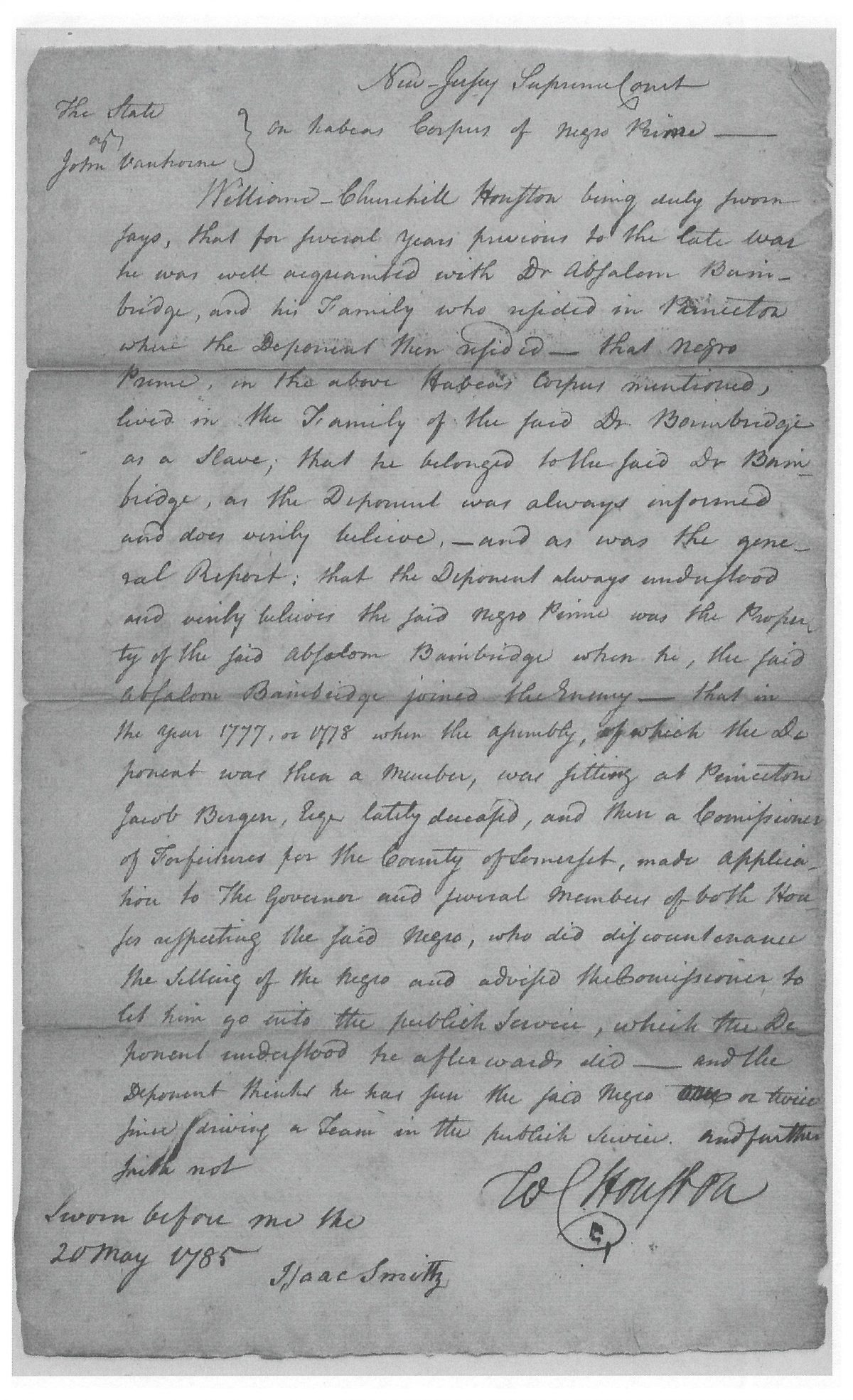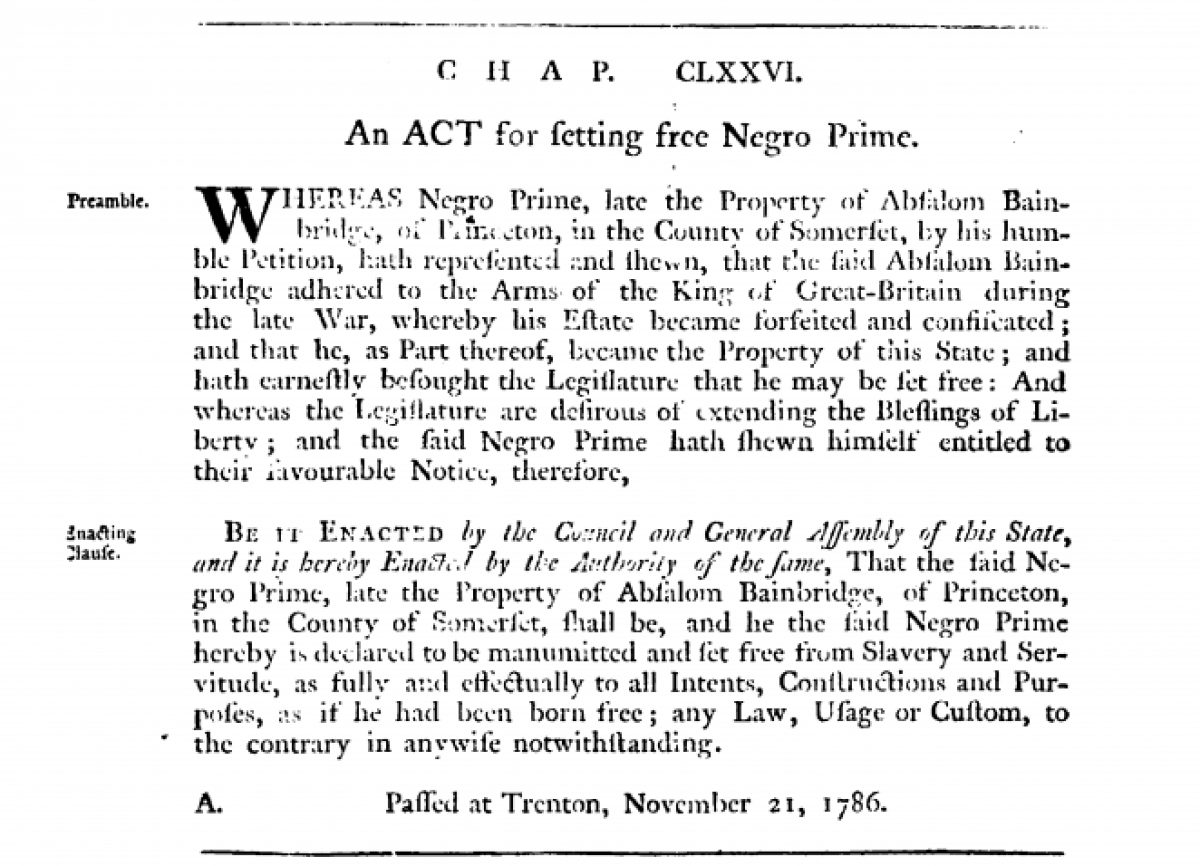[1]
Constance M. Greiff, “Bainbridge House,” Princeton History, vol. 1 (1971): 9-10.
⤴
[2]
Greiff, “Bainbridge House,” 14.
⤴
[3]
Giles R. Wright and Gloria Halpern, “Prime: Another Resident of Bainbridge House,” Princeton History, vol. 10 (1991): 63.
⤴
[4]
Wright and Halpern, “Prime,” 64. Indeed, Wright and Halpern note that “one index of the marginality of free New Jersey blacks was the ease with which they could be returned to bondage.”
⤴
[5]
John F. Hageman, History of Princeton and its Institutions (Philadelphia: J.B. Lippincott & Co., 1879), 70.
⤴
[6]
Francis B. Lee, ed., Genealogical and Personal Memorial of Mercer County, New Jersey (New York: The Lewis Publishing Company, 1907), 456.
⤴
[8]
Ibid.; Greiff, “Bainbridge House,” 14.
⤴
[9]
Alfred Jones, The Loyalists of New Jersey: Their Memorials, Petitions, Claims, Etc. from English Records, vol. 10 (Newark, NJ: New Jersey Historical Society, 1927), 15; Phyllis B. D’Autrechy, Some Records of Old Hunterdon County, 1701-1838 (Trenton, NJ: Trenton Printing Co., 1979); Stephen Wickes, History of Medicine in New Jersey and of its Medical Men (Newark, NJ: Martin R. Dennis & Co Newark, 1879), 131.
⤴
[10]
William S. Stryker, “The New Jersey Volunteers,” (Loyalists) in the Revolutionary War, (Trenton, NJ: Naar, Day, and Naar, 1887), 39; [James Rivington’s] Royal Gazette, 22 August 1778; Lee, Genealogical and Personal Memorial, 456.
⤴
[11]
Lee, Genealogical and Personal Memorial, 456.
⤴
[12]
“John Maclean, Jr.,” Presidents of Princeton University, Princeton University, accessed 8 July 2017, https://www.princeton.edu/pub/presidents/maclean/.
⤴
[13]
Petition for manumission of Negro Prime, BAH: Legislative Records, 1783-1787, Box 1-15, Department of Education, Series SEDSL006, New Jersey State Archives, Department of State, Trenton, New Jersey.
⤴
[14]
[James Rivington’s] Royal Gazette, August 22, 1778, p.3.
⤴
[15]
Ibid.; Stryker, The New Jersey Volunteers, 39; Wright and Halpern, “Prime,” 69.
⤴
[16]
“Act of New-Jersey to punish Traitors and Disaffected Persons,” Laws of 1776, ch. 5 (1776).
⤴
[17]
“An Act of free and general pardon, and for other purposes therein mentioned,” New Jersey (1777); “An Act for taking Charge of and leasing the Real Estates, and for forfeiting the Personal Estates of certain Fugitives and Offenders, and for enlarging and continuing the Powers of Commissioners appointed to seize and dispose of such Personal Estates, and for ascertaining and discharging the lawful Debts and Claims thereon,” Acts, 2nd G.A., 2nd sitting, ch. XXVII, pp. 73-82 (1778); “An Act for forfeiting to and vesting in the State of New Jersey, the Real Estates of certain Fugitives and Offenders, and for directing the Mode of determining and satisfying the lawful debts and demands which may be due from, or made against, such Fugitives and Offenders; and for other Purposes therein mentioned,” Acts, 3rd G.A., 1st sitting, ch. XIV, pp. 31-40 (1778).
⤴
[18]
Phyllis B. D’Autrechy, Some Records of Old Hunterdon County, 1701-1838 (Trenton, NJ: Trenton Printing Co., 1979). This text includes transcribed versions of original documents held by the Hunterdon County Historical Society, including the Loyalist Papers.
⤴
[19]
D’Autrechy, Some Records of Old Hunterdon County, 257; Wright and Halpern, “Prime,” 68; Jones, The Loyalists of New Jersey, 16.
⤴
[20]
In the eighteenth century, Princeton fell within the jurisdiction of Somerset County (today, it is within Mercer County). Maidenhead, or Lawrenceville, was in the jurisdiction of Hunterdon County. Bainbridge was a property owner in both.
⤴
[21]
Petition for manumission of Negro Prime, BAH: Legislative Records, 1783-1787, New Jersey State Archives.
⤴
[22]
Ibid.; Wright and Halpern, “Prime,” 67-8.
⤴
[23]
Wright and Halpern, “Prime,” 62; James Breig, “Finding Slaves in Unexpected Places: Keeping Blacks in Bondage Was Not a Southern Monopoly,” Colonial Williamsburg Journal (2005), accessed 8 July 2017, http://www.history.org/Foundation/journal/Winter05-06/slavery.cfm.
⤴
[26]
Petition for manumission of Negro Prime, BAH: Legislative Records, 1783-1787, New Jersey State Archives. General Putnam commanded the American troops occupying Princeton following their victory at the Battle of Princeton.
⤴
[27]
“Receipt for slave and other items-Mary Bainbridge”, 4 April 1777, MS775, Manuscript Collection, Historical Society of Princeton, Princeton, New Jersey.
⤴
[28]
Wright and Halpern, “Prime,” 68; Case 39106, Supreme Court Case Files, 1704-1844, New Jersey State Archives, Department of State, Trenton, New Jersey; Case 13549, Supreme Court Case Files, 1704-1844, New Jersey State Archives, Department of State, Trenton, New Jersey.
⤴
[29]
D’Autrechy, Some Records of Old Hunterdon County, 257.
⤴
[30]
Book 63, Supreme Court of New Jersey Minutes, 1704-1873, Series SSV00002, Volume 18, New Jersey State Archives, Department of State, Trenton, New Jersey.
⤴
[32]
Book 63, Supreme Court of New Jersey Minutes, 1704-1873, Series SSV00002, Volume 18, New Jersey State Archives, Department of State, Trenton, New Jersey; Case 13549, Supreme Court Case Files, 1704-1844, New Jersey State Archives, Department of State, Trenton, New Jersey.
⤴
[33]
Wright and Halpern, “Prime,” 68.
⤴
[34]
BAH: Legislative Records, 1783-1787, Box 1-15, Department of Education, Series SEDSL006, New Jersey State Archives, Department of State, Trenton, New Jersey.
⤴
[35]
Wright and Halpern, “Prime,” 69
⤴
[36]
Ibid.; James McLachlan, Princetonians: 1748-1768: A Biographical Dictionary (Princeton, NJ: Princeton University Press, 1976), 645; Paul G. E. Clemens, “William Churchill Houston,” Rutgers University, accessed 8 July 2017, http://fashistory.rutgers.edu/clemens/constitutional1/wchouston.html.
⤴
[37]
Petition for manumission of Negro Prime, BAH: Legislative Records, 1783-1787, New Jersey State Archives.
⤴
[39]
“An Act for setting free Peter Williams, a Negro, late the Property of John Heard,” Acts, 8th G.A., 2nd sitting, ch. LIII, p. 110 (1784); Wright and Halpern, “Prime,” 63.
⤴
[40]
“An Act for setting free Negro Prime,” Acts, 11th G.A., 1st sitting, ch. CLXXVI, p. 368 (1786); Votes and Proceedings of the Eleventh General Assembly, 25, 28, 32, 35, 36, 65.
⤴
[41]
Wright and Halpern, “Prime,” 69.
⤴





